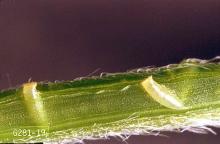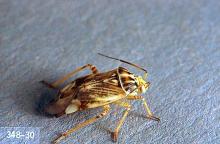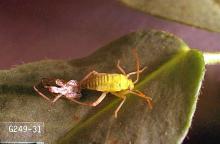Includes
Pale legume bug (Lygus elisus)
Tarnished plant bug (Lygus lineolaris)
Western tarnished plant bug (Lygus hesperus)
Pest description and crop damage Adult lygus bugs are oval, about 0.19 inch in length with a light yellow 'V' on the back. There are three species that attack tree fruits and the body color may be green or brown. The bugs feed on developing leaves, flowers and fruit. Most fruit damage occurs shortly after bloom on fruitlets. Dimpling and deep pitting of fruit are indications of early feeding damage. Cat-facing damage is a fruit deformity that occurs when cells surrounding the dead cells at the feeding site continue to grow as the fruit matures, resulting in severely misshapen fruit.
Biology and life history These insects overwinter as adults in protected areas such as leaf debris, bark cracks, or similar spaces. Adults become active in early spring, feeding on buds of trees and shrubs before moving to other plants. Eggs are laid in the stems and other tissues of host plants. There may be several generations per year.
Management-cultural control
Eliminate weeds that serve as protection and early season food for the insect. Lygus problems are most likely to occur with alfalfa or unmanaged borders. Eliminate border habitat or target management on border rows. Hand-thin damaged fruit.
Spring and summer
Management-chemical control: HOME USE
- azadirachtin (neem oil)-Some formulations are OMRI-listed for organic use.
- carbaryl-Highly toxic to bees.
- gamma-cyhalothrin-Highly toxic to bees.
- kaolin clay-Applied as a spray to leaves, stems, and fruit, it acts as a repellant to target pests. Some formulations are OMRI-listed for organic use.
- permethrin-Highly toxic to bees.
- pyrethrins-Highly toxic to bees. Some formulations are OMRI-listed for organic use.
- zeta-cypermethrin-Highly toxic to bees.
Management-chemical control: COMMERCIAL USE
- acetamiprid (Assail 70WP) at 1.7 to 3.4 oz/A in up to 100 gal water per application. Do not make more than four applications per year or exceed 13.5 oz/A per growing season. Will provide suppression. Do not apply during bloom. REI 12 hr. PHI 7 days. [Group 4A]
- flonicamid (Beleaf 50 SG) at 2.0 to 2.8 oz of product/A in up to 100 gal water per application. Do not apply more than three applications per season. REI 12 hr. PHI 21 days. [Group 29]
- lambda-cyhalothrin (Warrior II) at 1.28 to 2.56 fl oz in enough water to achieve thorough coverage. REI 24 hr. PHI 21 days. [Group 3]
- thiamethoxam (Actara WDG) at 4.5 to 5.5 oz/A in up to 100 gal water per application. Do not exceed 16.5 oz/A per season. REI 12 hr. PHI 35 days. [Group 4A]
- zeta-cypermethrin (Mustang Maxx) at 1.28 to 4.0 fl oz/A in a minimum of 100 gal water for dilute spray. REI 12 hr. PHI 14 days. [Group 3A]






